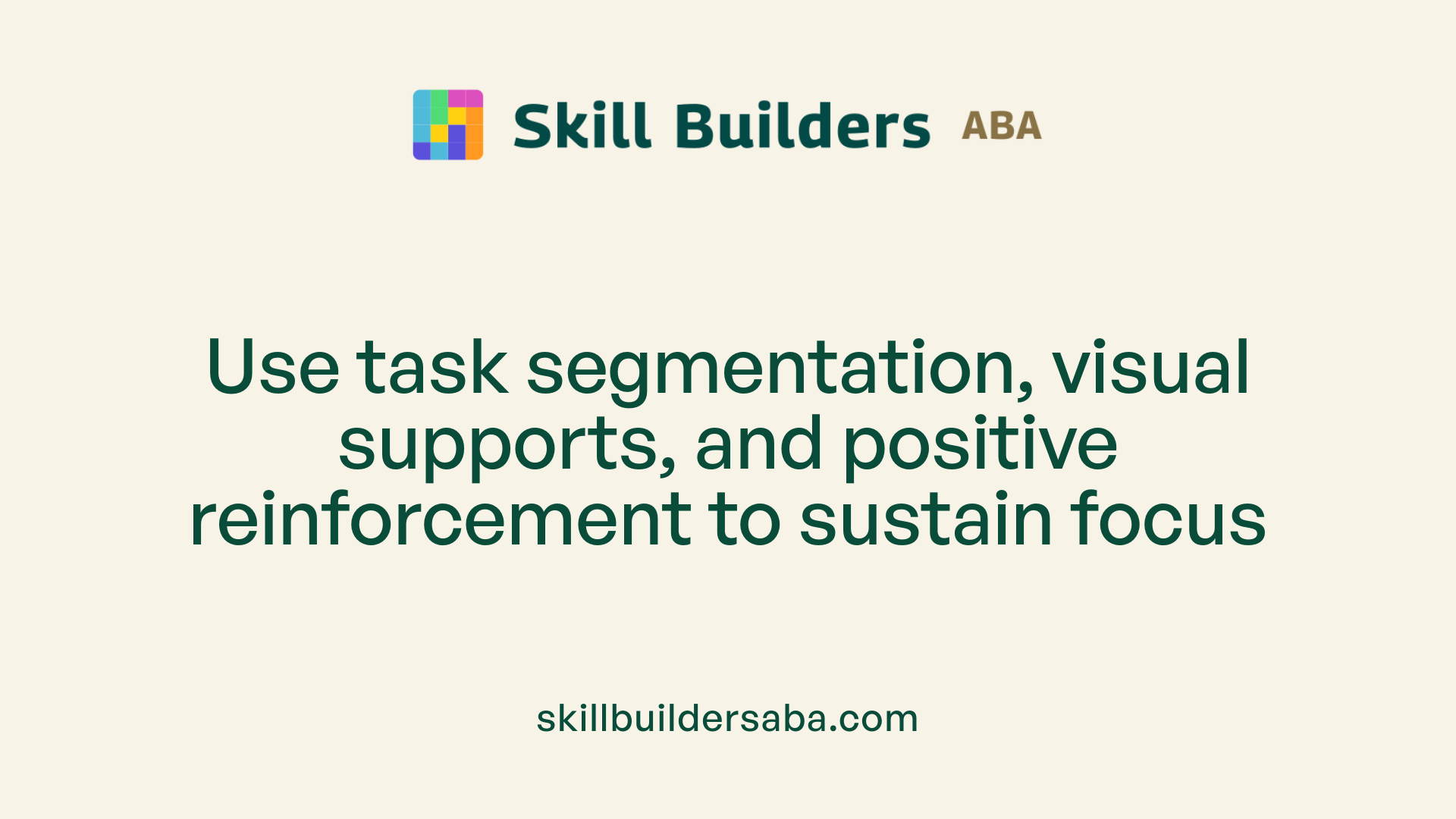
How to gradually increase task demands in therapy
Strategies for Progressive Challenge in Therapeutic Settings
Enhancing Therapy Effectiveness Through Incremental Task Demands
Gradually increasing task demands in therapy is a critical approach for fostering skill development, promoting confidence, and maintaining motivation in clients. This strategy involves systematic adjustments to activity complexity, tailored to individual abilities, and backed by evidence-based techniques. By thoughtfully modulating the difficulty level of tasks, therapists can create a supportive environment that encourages steady progress while reducing frustration and resistance.
Understanding the Importance of Tracking Progress
Why is tracking progress important in therapy, and how can it be done effectively?
Tracking progress plays a vital role in therapy because it helps both clients and clinicians see tangible evidence of improvement over time. It provides a clear picture of what is working and what might need adjustment, ensuring that interventions are tailored to meet individual needs.
To do this effectively, therapists often use a mix of assessment methods. Standardized tools like the PHQ-9 for depression or GAD-7 for anxiety help quantify symptoms. Behavioral logs and session rating scales capture day-to-day changes and client satisfaction, while narrative reflections allow clients to express their personal experiences.
Visual aids, such as charts or progress graphs, make data more accessible and engaging for clients. Sharing this information regularly encourages motivation, promotes self-awareness, and fosters collaboration between therapist and client.
Implementing feedback-informed care systems further enhances therapy effectiveness. These systems involve ongoing evaluation of progress, allowing clinicians to identify when a client isn’t advancing as hoped and to adjust strategies promptly.
Successful progress monitoring also depends on establishing baseline measurements at the start of therapy, selecting appropriate tools tailored to individual goals, and maintaining honest, transparent communication. Respecting ethical considerations ensures clients feel safe sharing sensitive information.
Methods of progress monitoring in therapy
- Standardized assessment tools (e.g., PHQ-9, GAD-7)
- Session rating scales
- Behavioral logs
- Narrative reflections
- Visual charting and graphs
By integrating these approaches, therapists can effectively track development and support meaningful, measurable change in their clients.
Analyzing Activity Demands for Tailored Interventions
What factors influence the level of detail needed in a task analysis?
Determining how detailed a task analysis should be depends largely on the individual learner’s needs and the specific context of the activity. When planning interventions or teaching new skills, it is essential to consider the learner’s current abilities and potential challenges.
One major factor is the complexity of the skill itself. More complex tasks often require a step-by-step breakdown, using visual cues or prompts to guide the learner through each part of the process. For simpler tasks, a less detailed analysis may suffice.
The purpose of the analysis also influences its depth. If the goal is to monitor performance or identify specific skill deficits, a detailed breakdown ensures that every component is addressed. On the other hand, if the focus is on providing general guidance or support, a broader overview might be enough.
Another consideration is the learning environment and available materials. In settings with limited resources, simplified analysis may be necessary, while more detailed planning is feasible where multiple aids or sensory supports are available.
Furthermore, the individual’s age, cognitive level, and physical abilities can dictate the level of detail required. For learners with cognitive impairments, highly structured, detailed task breakdowns can facilitate understanding and success.
Ultimately, the goal is to develop a task analysis that enhances learning and independence. Careful assessment helps ensure that steps are neither too overwhelming nor too vague, providing just the right amount of support for the learner’s development.
Facilitating Skill Development via Task Analysis
How does task analysis facilitate skill development in therapy?
Task analysis plays a crucial role in helping individuals acquire new skills, especially in therapeutic settings. By breaking down complex activities into smaller, manageable steps, therapists can tailor their approaches to fit each person's unique needs and current abilities.
This systematic breakdown makes learning less overwhelming and more attainable. It also allows for the use of targeted teaching strategies such as visual supports, checklists, and chaining procedures. For example, forward chaining teaches skills step-by-step from the beginning to the end, while backward chaining starts from the final step, helping learners achieve success early on.
Using visual supports — like picture schedules or step-by-step guides — further clarifies expectations and provides learners with a clear picture of what to do next. This method not only promotes understanding but also reduces anxiety related to new or complex tasks.
Monitoring progress is another benefit of task analysis. It helps therapists identify which steps a learner finds challenging, enabling timely adjustments to instruction. By tailoring the task to the individual's current skill level, environmental factors, and personal goals, the process becomes more effective.
In practice, task analysis supports skill mastery across many areas, including daily living, communication, and social interaction. It creates a structured learning environment that encourages confidence, independence, and motivation.
How does task analysis support learning?
Overall, task analysis provides a clear, organized framework for teaching new skills. It fosters incremental learning, reduces potential frustrations, and helps ensure sustained progress. This structured approach is essential in maximizing therapeutic outcomes and empowering individuals to reach their full potential.
Using Visual Supports to Enhance Engagement and Learning

The role of visual cues
Visual supports play a vital role in helping learners understand expectations, organize tasks, and stay engaged. They prepare learners for upcoming activities, significantly reducing anxiety by providing clear, concrete information about what to expect. For example, visual schedules outline daily routines, while social stories depict appropriate behavior in various situations. Visual cues serve as reminders and guides, making transitions smoother by reducing uncertainty and helping prevent behavior issues stemming from confusion.
Examples of visual supports
There are many practical visual supports used in therapy and educational settings. Some common examples include:
| Type of Visual Support | Description | Purpose |
|---|---|---|
| Schedules | Visual timelines or charts showing daily activities | Promote predictability and independence |
| Social Stories | Illustrated narratives explaining social situations | Teach social norms and reduce anxiety |
| Visual Cues | Objects, pictures, or symbols indicating needed actions | Support task initiation and completion |
| Choice Boards | Displays of options for activities or materials | Foster decision-making and control |
| Visual Reminders | Sticky notes, labels, or signs | Reinforce rules and routines |
Incorporating these supports helps create a structured environment where learners can succeed by accessing information visually. Adjusting supports to match individual abilities ensures that each person benefits from strategies tailored to their needs, ultimately encouraging participation and reducing frustration.
Increasing On-task Behavior and Engagement

What techniques can be used to improve on-task behavior and engagement through progressive demands?
Enhancing on-task behavior and engagement often involves gradually increasing the difficulty or duration of activities to match the learner’s developing skills. One effective strategy is breaking tasks into smaller, manageable steps, which prevents learners from feeling overwhelmed. As they gain confidence with each step, educators can slowly raise the complexity or extend activity periods, encouraging sustained focus.
In addition to task segmentation, incorporating movement breaks or physical activity refreshes attention and helps maintain motivation. This approach not only prevents fatigue but also promotes better focus during longer learning sessions.
Creating a structured environment with visual supports, such as schedules or cues, reduces distractions and clarifies expectations. Offering choices regarding tasks, materials, or the order of activities empowers learners, making them feel in control and more engaged.
To further boost on-task behavior, frequent instructional changes every 15 to 20 minutes—like switching activities or teaching methods—can keep learners interested and prevent boredom. Explicitly teaching attention strategies and encouraging self-assessment foster independence and self-regulation.
Reinforcing progress with positive feedback and ensuring activities are personally relevant help sustain motivation. Establishing consistent routines provides a predictable framework, which reassures learners and promotes consistent engagement over time.
| Strategy | Description | Effective Example |
|---|---|---|
| Break tasks into smaller steps | Reduce complexity for easier mastery | Completing one part of a multi-step activity before moving on |
| Use visual supports | Clarify expectations and steps | Visual schedules, checklists |
| Incorporate movement | Refresh attention periodically | Short exercise breaks between learning segments |
| Offer choices | Increase learner control | Choosing between different tasks or materials |
| Change activities frequently | Prevent boredom | Switching tasks every 15-20 minutes |
| Reinforce progress | Encourage continued effort | Giving praise or small rewards |
| Establish routines | Provide predictability | Consistent start and end times for activities |
Strategies for progressively increasing demands help learners build confidence and extend their stamina for focus, leading to improved on-task behavior and overall engagement.
Best Practices for Activity Grading

What are best practices for activity grading and task progression in occupational and behavioral therapy?
Effective activity grading involves systematically adjusting the difficulty of tasks to match the individual’s current abilities while promoting progress. The process begins with a detailed analysis of the activity, breaking it into smaller, manageable steps to identify specific demands. This decomposition helps therapists tailor interventions to meet each client's unique needs.
Gradually increasing (grading up) or decreasing (grading down) task demands ensures the challenge remains appropriate, fostering engagement and reducing frustration. These adjustments should be informed by continuous assessment and observation of the client's performance, allowing therapists to maintain a 'just-right' challenge that builds confidence and skills.
Modifications play a crucial role in activity grading. They can include simplifying instructions, reducing physical or cognitive complexity, and providing environmental supports such as visual cues or assistive technology. For example, a task might be made easier by using adaptive equipment or breaking it into smaller parts.
Accurate documentation of all modifications and progress is fundamental. Recording the rationale behind each change helps track client development and guides future planning. Employing clinical reasoning supported by evidence ensures interventions are targeted and effective.
In summary, best practices involve thorough activity analysis, incremental adjustments tailored to individual responses, strategic modifications, and diligent documentation. These approaches promote skill mastery, enhance motivation, and support goal achievement across diverse therapeutic contexts.
Effective Strategies for Increasing Demands Gradually

What are effective strategies for gradually increasing task demands during therapy sessions?
Progressively challenging clients is a vital element of successful therapy. Several well-established strategies ensure that the complexity of activities develops at an appropriate pace, fostering confidence and skill mastery.
One fundamental approach is task grading and systematic activity progression. This involves adapting tasks to align with the individual’s current abilities and then incrementally increasing difficulty levels. For example, a client might start with a simple matching task and move toward more complex problem-solving exercises as they gain proficiency.
Incorporating structured problem-solving techniques further enhances this process. Techniques such as generating multiple solutions, decision-making, and plan formulation help clients approach challenges systematically. These methods not only solidify understanding but also empower clients to handle increasing complexity independently.
The use of visual supports, including worksheets, pictorial cues, and task analysis charts, plays a crucial role. Breaking down complex tasks into smaller, manageable steps allows clients to focus on one aspect at a time, reducing feelings of being overwhelmed.
Behavioral strategies from applied behavior analysis (ABA), like chaining and prompting, are also employed to scaffold skill development. Chaining involves linking small steps into a complete activity, gradually increasing the complexity of each link. Prompting offers guidance at each stage, with fading prompts over time to promote independence.
Monitoring responses closely is essential. Therapists should observe how well the client manages increased demands and adjust the difficulty accordingly. This dynamic, responsive approach helps ensure that activity demands are challenging yet attainable.
In summary, combining task grading, problem-solving techniques, visual supports, and ongoing monitoring creates an effective framework for increasing task difficulty in therapy, promoting continuous growth and skill acquisition.
Structuring Activities to Support Developmental Skills
How can therapy activities be structured to support developmental skill development through progressive task demands?
Therapy activities can be effectively organized by gradually increasing the complexity and difficulty of tasks, carefully aligned with the individual's developmental level. This step-by-step approach ensures that each skill is mastered before moving on to more challenging tasks.
Initial assessments help identify a person's current abilities across areas such as cognition, motor skills, social skills, and emotional regulation. Based on these insights, therapists design activities that start at a manageable level and build toward more complex behaviors.
For example, a child working on emotional understanding might begin with recognizing simple facial expressions, then progress to understanding feelings in different contexts, and eventually to perspective taking.
Activities should relate to real-life situations to boost motivation and ensure skills are functional. Routine-based activities, like morning routines or play sequences, serve as meaningful practice opportunities.
Incorporating routine schedules and purposeful, engaging activities helps children see the relevance of their learning. For example, practicing with grocery shopping tasks can reinforce social and cognitive skills.
Collaboration with families plays a vital role. When parents and caregivers are involved, they can reinforce progress through home activities that mirror therapy tasks, promoting generalization across environments.
By systematically adjusting these activities—adding complexity only after previous steps are mastered—therapists help children develop skills in a secure, encouraging setting. This gradual increase in demands supports confidence, motivation, and long-term functional development.
Understanding the importance of developmental appropriateness and meaningful engagement ensures therapy is both effective and enjoyable, setting children on a successful path toward independence and improved participation in daily life.
Adapting Tasks to Challenge Clients Progressively
How can therapists adapt tasks to progressively challenge clients?
Therapists play a crucial role in ensuring their clients are continually growing without feeling overwhelmed. One effective approach is to gradually increase the difficulty level of activities. This can be achieved by slowly adding more complex components or reducing the amount of support and guidance provided.
Tailoring these challenges to the individual's current ability is essential. For example, if a client is working on a motor skill, the therapist might start with simple movements and gradually introduce more demanding tasks as confidence and coordination develop.
Creating a supportive and responsive environment helps clients feel safe to take risks. Using collaborative techniques like setting personalized goals or employing open-ended questions encourages clients to participate actively in their progress.
Incorporating creative methods such as role-playing, arts, or experiential activities can make challenges less intimidating. These methods engage clients emotionally and mentally, fostering motivation.
Maintaining a trusting relationship, offering empathetic support, and timing challenges appropriately are critical. When challenges are aligned with the client's resilience and readiness, they promote steady development and reinforce a sense of achievement.
In summary, by carefully scaling tasks, personalizing challenges, and nurturing a positive environment, therapists ensure that clients are appropriately challenged, which supports ongoing growth and confidence.
The Role of Shaping in Behavior Change

What is shaping in ABA therapy?
Shaping is a fundamental strategy used in Applied Behavior Analysis (ABA) to modify or develop new behaviors by reinforcing successive steps that gradually lead to the desired outcome. It involves breaking down complex behaviors into smaller, more manageable parts and encouraging progress through careful reinforcement of these incremental steps.
How is shaping implemented in therapy?
In practical terms, therapists initiate shaping by rewarding any initial behavior that is even remotely related to the target skill. As the individual demonstrates these preliminary steps, the therapist gradually alters the reinforcement criteria to focus on closer approximations of the final goal. For example, when teaching a child to say a new word, the therapist might reinforce any vocalization initially and then selectively reinforce more accurate pronunciations.
The process often involves prompts, which are gradually faded as independence increases. Data collection is critical to monitor progress and Adjust strategies as needed. This disciplined approach ensures that each small success builds toward more complex skills, fostering motivation and confidence.
Shaping applies across many areas, from learning communication—moving from sounds to words—to developing daily living skills, such as dressing or toileting. It’s especially valuable because it creates a step-by-step pathway for skill acquisition, reducing frustration and preventing a sense of failure.
This technique is evidence-based and versatile, supporting individuals in acquiring behaviors that might seem challenging at first glance. By rewarding small, successive improvements, shaping helps learners master skills in a structured, confidence-building manner.
Targeting Each Step in a Task Analysis Effectively
What does targeting each step of a task analysis involve?
Focusing on each part of a task analysis means teaching and reinforcing discrete components of an activity to build full mastery. Instead of expecting a learner to do everything at once, instruction is divided into smaller, manageable steps.
The process often uses methods like forward chaining, where teaching begins with the first step, or backward chaining, which starts with the last step. This sequential approach helps learners grasp each part thoroughly and gain confidence as they progress.
Support and feedback are integral during this process. Teachers or therapists provide prompts and cues tailored to the learner's needs and gradually fade them as independence increases.
Monitoring progress through data collection is also vital. Tracking how well a learner performs each step allows practitioners to identify areas needing additional support and to adjust teaching strategies accordingly.
Overall, targeting each step ensures that even complex tasks are broken down into achievable parts. This approach accommodates individual differences, making learning more effective and less overwhelming for learners with diverse needs.
Harnessing Systematic Approaches for Continuous Progress
Incrementally increasing task demands in therapy requires a strategic combination of assessment, analysis, structured teaching, and flexibility. Using tools like task analysis and visual supports, alongside techniques such as shaping, chaining, and activity grading, therapists can create personalized, developmentally appropriate challenges. Effective monitoring and responsive adjustments ensure that progression is steady and supported, fostering skill mastery, confidence, and independence in clients. Embracing these best practices leads to meaningful and sustained therapeutic outcomes.
References
- How to Improve On Task Behavior in ABA Therapy - Ujala Life
- Behavior Shaping & Gradual Steps Toward Positive Change
- [PDF] Activity Gradation and Adaptation
- Mastering Activity Demands in OT - Number Analytics
- Behavior Shaping & Gradual Steps Toward Positive Change
- How to Use Shaping Procedures in ABA
- Shaping - KSDE TASN
- Shaping: 5 Tips You Need to Know to Use it Effectively
Information When You Need It
To see if Skill Builders ABA is the right fit, you can read about our approach and values online. If you would rather talk through the logistics with a coordinator, drop us a line and we’ll get back to you.
Reach Out Today
Learn more about how we can support your child’s growth and development. Contact us to discuss our services and availability in your area.
.svg)